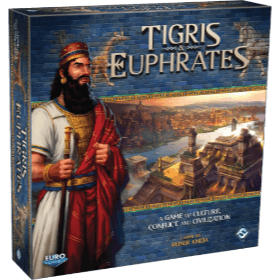Tigris & Euphrates
 An award winning Reiner Knizia game of tile laying set in the Tigris and Euphrates river valley. You take the role of civilizations competing in four categories. The scoring system encourages diversification as final scores are a player's lowest category. Players race to construct monuments, which supply steady points, while trying to defend their territory from internal and external conflicts.
An award winning Reiner Knizia game of tile laying set in the Tigris and Euphrates river valley. You take the role of civilizations competing in four categories. The scoring system encourages diversification as final scores are a player's lowest category. Players race to construct monuments, which supply steady points, while trying to defend their territory from internal and external conflicts.
Number of players: 2 - 4
Game duration: 40 mn
Complexity: 3 / 5
Play Tigris & Euphrates and 988 other games online.
No download necessary - play directly from your web browser.
With your friends and thousands of players from the whole world.
Free.

Play Tigris & Euphrates and 988 other games online.
No download necessary - play directly from your web browser.
With your friends and thousands of players from the whole world.
Free.

Rules summary
Summary
You play as the leader of a civilization in fertile Mesopotamia (which means "between two rivers.") By laying tiles of different types, you will shape the landscape of this ancient region, fight wars, suppress or lead revolts, and watch cities rise and fall, all while attempting to gain influence in 4 key areas. At the end of the game the winner is the person with the highest influence in their lowest category.
Each player is represented by a specific shape (Bull, Urn, Bow and Lion) rather than a color.
| Color | Tile | Leader | Leader Ability | Tile Counts |
|---|---|---|---|---|
| Black | Settlement | King | Scores unclaimed influence on tile lays | 30 |
| Green | Market | Trader | Collects treasures | 30 |
| Red | Temple | Priest | - | 57 |
| Blue | Farm | Farmer | - | 36 |
| Yellow | Catastrophe | - | - | 2 per player |
You have one leader in each sphere of influence (red bow, green bow, etc) and influence points will flow through them.
Actions
You will get 2 actions on each turn, and there are 3 possible actions.
• Place a tile - Take a tile from your hand and place it anywhere on the board.
• Position a leader - Place a leader from your hand, move a leader on the board, or take a leader back to your hand from the board.
• Discard - Discard any number of tiles from your hand and redraw that many.
After your two actions you redraw to 6 and the next player goes.
Leader Positioning
A leader may be positioned from your hand to the board, from the board to another spot on the board, or returned from the board to your hand with the following restrictions.
• A leader must be placed on an empty space
• A leader must always be adjacent (common edges, not diagonal) to a temple (red tile)
• A leader may not be placed to join kingdoms
• A leader cannot be placed on a river
Placing a leader does not award any points. However, a player may not score any points without having at least one leader on the board.
If a leader is placed in a kingdom containing a similar colored leader, then a revolt occurs.
Revolt
A revolt occurs when a player places a leader in a kingdom that already contains a leader of that color.
The newly placed leader is the attacking leader and the opposing leader is the defender.
To resolve the revolt strength needs to be determined.
• First count the number of temples (red tiles) adjacent to each leader, that is their board strength.
• Then the attacking player may commit temples (red tiles) from their hand as additional support.
• After seeing the attacking leader's support the defender may likewise commit temples (red tiles) from their hand as support.
The winner is the leader with the greater total strength (board strength + committed support); the defender always wins ties.
The losing leader is returned to their owner's hand, and the winner scores one red. Tiles committed for support tiles are discarded by both attacker and defender.
Tile Placement
Tiles can be placed anywhere on the map with the following restrictions:
• No tiles except for blue may be placed on rivers
• Blue tiles can only be placed on rivers
• No tile may be placed on top of a leader or a monument
• Only catastrophes can be placed on other tiles
When a tile is placed in a kingdom, the leader of the matching color in that kingdom is awarded an influence point of the tile's color. If there is no leader of that color, but there is a king (black leader), then the king (black leader) is awarded an influence point of the tile's color.
If a tile is placed such that it joins two kingdoms, a war is started and no influence point will be awarded for the tile placement (even if there are no opposing leaders). A tile may not be placed so as to join more than two kingdoms.
If a tile is placed such that a 2x2 square of like-colored tiles now exists, a monument of a matching color may be built.
War
A war occurs when a player places a tile that joins two kingdoms. All leaders that have a like-colored leader in the joined kingdom are in conflict.
Wars are resolved through the following steps.
• Determine the leader: The active player may select any color of leaders to resolve first.
• Determine the attacker/defender: If the active player selects a color for which they have a leader, they will be the attacker, otherwise the next player in turn order with a participating leader is the attacker.
• Count board strength for attacker and defender: In a war, a leader's board strength is the number of like-colored tiles in their kingdom.
• Play support from hands: Starting with the attacker, play tiles from hand matching the attacking/defending leader color as committed support. Both attacker and defender will discard these committed-support tiles at the end of the conflict.
• Determine winner: The winning leader is the leader with greater total strength (support on the board + committed support); the defender always wins ties.
• Remove tiles and award points: The loser withdraws from the kingdom their leader and all tiles supporting that leader. This may break apart the kingdom. The winner scores one influence of the defending leader's color plus one influence matching the color of each tile removed from the kingdom.
If the war involved priests (red leaders), then no temples (red tiles) supporting another leader (i.e., the temple tiles which were directly adjacent to the removed leader) or containing treasures are removed.
If there are still leaders in conflict, continue to the next war, with the original player picking the next color.
Scoring
Influence points come in 4 colors and are hidden during the game.
Your score at the end of the game is your lowest color of influence. Treasures are wild points which you can assign to any color.
On BGA, treasures are automatically distributed one at a time to your current lowest color of influence. (e.g. If you ended the game with an influence of 8-8-8-7 and 5 treasures, the treasures would be assigned to yellow, then red, then green, then blue, then yellow again, putting you at 9-9-9-9, and scoring 9.)
Kingdoms
A kingdom is a region of tiles and leaders that are adjacent (common edges, not diagonal) to each other. A kingdom may contain leaders of different players as long as they are different colors.
Monuments
Whenever a player places the fourth tile in a 2x2 square of the same color, a monument may be built on the spot. The tiles are flipped over and a monument is placed on them. The monument has 2 colors, and one of those colors must match the flipped tiles.
Monuments regularly provide influence. Every monument awards 1 influence to the active player at the end of their turn for each of their like-colored leaders in the monument's kingdom.
Monuments do not have a color of their own for purposes of supporting leaders or counting as board strength.
Treasures
Treasures are wild points. At the start of the game all 10 temples on the board start with a treasure on them.
After placing a tile and resolving any wars if a kingdom contains 2 treasures and a green leader, the leader's owner picks up one of the treasures. Some of the starting temples have an extra border around them, those treasures must be taken first if there is an option.
Catastrophe Tiles
Each player starts the game with 2 catastrophe tiles, which cannot be discarded.
Catastrophe tiles may be played on empty spaces or on top of other tiles, but not on top of leaders or monuments. They destroy the tile under them and do not serve as a part of any kingdom.
Game End
The game ends when only 2 treasures remain on the board, or the draw pile runs out (remaining tiles are tracked as progress at the top left and the "bag" tracker on the right).
Variants
Game Board - Advanced Board
Different map with 14 treasures compared to 10 treasures on Standard map.
War Support - English Variant
During a conflict (war or revolt) both the attacker and defender are only able to contribute tiles if the total would exceed the strength of the other. This variant prevents players from using conflicts as a way to simply dump tiles from their hand.
Advanced Games Rules - Civilization Buildings
There are four civilization buildings: Palace (black), Market Hall (green), Library (red), Granary (blue).
When a player places a tile so that there are three or more in a row (horizontal or vertical) they may place the same color building on any of those tiles.
If the building is already on the board, a player may move it to another row if it is longer than the one it is currently on (additionally the new line must be at least 3 long as per the first rule).
Tiles that have a building cannot be destroyed by war, revolt, or catastrophe. They can be flipped to create a monument which takes the building off the board.
Civilization buildings must be placed prior to building a monument or wonder.
Placing a tile into a kingdom that contains a building gives the leader there two cubes instead of one (blue leader receives two blue cubes instead of one, etc.).
Monuments - Wonder Variant
The wonder is a special, single, five-tile monument in a cross-like shape (four orthogonal tiles connected to a center tile). A player may build this wonder when they place a tile that results in a cross-like shape of a single color. All rules for monuments apply.
At the end of a turn in which a player has a King connected to the wonder, they may receive a cube of any color they choose.
Scoring - Open Scoring
Influence is not hidden during the game.


